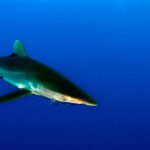
Have you ever wondered if the great white shark has the capacity to play? Can they engage in leisure activities like other animals? Scientists argue that due to their solitary nature and predatory behavior, it’s unlikely for them to display traditional forms of play.
But recent studies suggest a different perspective. For example, they’ve been seen ‘spy hopping’, where they stick their heads out of the water to get a better view. This serves a purpose, but hints at a playful curiosity.
As we explore this enigmatic world beneath the seas, we’re starting to unravel more secrets. We can’t be sure if traditional play aligns with their predatory instincts, but subtle behaviors and encounters suggest they may have the capacity for play in their own unique way.
Key Takeaways
- Great white sharks exhibit playful behavior, challenging the perception that they are solely aggressive predators.
- Playful behavior in great white sharks includes breaching, spy-hopping, and interacting with objects in their environment.
- Play behavior in sharks may serve various purposes, such as social bonding, learning, and practicing hunting techniques.
- The study of play behavior in great white sharks is challenging due to their elusive nature and the difficulty of observing them in their natural habitat.
- Understanding the playful nature of great white sharks can help in developing conservation strategies and promoting their protection.
The Behavior of Great White Sharks

To gain a comprehensive understanding of the behavior of great white sharks, delve into their hunting and feeding habits, as well as their social interactions and communication. Discover the intricacies of how these apex predators navigate their environment and interact with other members of their species.
Hunting and Feeding Habits
Great white sharks are famed for their hunting and feeding techniques. Their mind-boggling ability to capture their prey highlights their skill and adaptability.
Let’s look at their food sources and strategies:
| Food Sources | Hunting Strategies |
|---|---|
| Seals | Ambush from below |
| Fish | Quick bursts of speed |
| Cetaceans | Stealthy approach |
These show the varied ways great white sharks hunt and acquire meals. When targeting seals, they use patience and sudden bursts of energy. When after fish, they use quick bursts of speed. And when taking on cetaceans, they employ a calculated stealth approach.
Witnessing the accuracy and effectiveness with which great white sharks hunt is astonishing. They have perfected their instincts over centuries, striking success every time.
Now you know about their hunting prowess, stay informed on the latest research about these marvelous creatures. Keep exploring and uncovering the deep sea’s secrets, so you never miss out on amazing finds!
Social Interactions and Communication

Social interactions and communication among great white sharks are vital for their survival. These play a huge role in dominance, mating, and resources.
- Establishing Dominance: Sharks use fin slaps, jaw snaps, and body ramming to show dominance or to assert it.
- Body Language: Sharks use body postures and movements to express intentions, such as feeling threatened or looking for a mate.
- Tail Slapping: Tail slapping is a communication method used to deter competitors or predators.
- Visual Cues: Eye contact can convey messages of dominance or submission.
- Chemical Signals: Sharks release pheromones to convey information about sex, reproductive state, and health.
These interactions reveal the complex dynamics of great white shark populations. Each interaction has significance in order and survival.
To promote communication among them:
- Observe from a safe distance in the wild.
- Support conservation of habitats.
- Educate about healthy ecosystems.
- Encourage responsible fishing.
- Implement regulations to prevent human disruption.
- Research communication signals and social structures.
By respecting their natural behaviors, protecting their habitats, and understanding their social interactions, we can help preserve great white sharks and our oceans.
Understanding Play in Animals
To understand play in animals like great white sharks, delve into the section ‘Understanding Play in Animals’ with its sub-sections: ‘Definition and Types of Play’ and ‘Play Behavior in Different Species’. Explore how these sub-sections contribute to unraveling the mysteries of play and its significance in the lives of various animal species.
Definition and Types of Play
Play in animals means different recreational activities for non-human creatures. It is important; it helps with skills, social bonding, and reducing stress. Animals do various types of play, each with a purpose.
Let’s check out the kinds of play in a table:
| Type | Description |
|---|---|
| Locomotor | Running, jumping, or climbing |
| Object | Playing with toys or objects |
| Social | Interacting with each other |
| Cognitive | Solving tasks to stimulate the mind |
Remember, some things influence play. For example, what species and age the animal is. Also, the complexity and variety of play show how animals can adjust to their environment.
To help animals, here are some tips:
- Give them toys or objects that resemble nature to do object play.
- Give them chances to be social with other animals.
- Make tasks for them to do for cognitive play.
We can make animals happier by giving them enjoyable activities and making sure they do the right type of play. This helps them feel better and have a better life. From dogs chasing tails to cats attacking make-believe prey, animals sure know how to have fun!
Play Behavior in Different Species
Play behavior among various species varies widely. Animals engage in play for various reasons, like forming social bonds, developing hunting skills, or just for fun.
Primates, for example, have been seen engaging in social play, object play, and chasing games. Birds, such as crows, do object play and aerial acrobatics to improve their cognitive abilities. Canines, like dogs, play socially, with objects, and chase each other to strengthen their bonds. Cats, on the other hand, use object play and solitary predatory play to refine their hunting skills.
In addition, some species engage in unique forms of play. Dolphins toss seaweed and small shells to each other, and octopuses have been observed manipulating toys with their tentacles.
Do Great White Sharks Play?
To gain deeper insights into the fascinating topic of whether great white sharks play, explore the observations and research surrounding this behavior. Delve into the arguments that support or challenge the idea of play behavior in these magnificent creatures.
Observations and Research
Do great white sharks play? Researchers have uncovered fascinating details about their playful tendencies. Through careful observations and research, scientists have been able to observe sharks interacting with inanimate objects, such as kelp or buoys, in a seemingly playful manner. Also, great whites were seen leaping out of the water in what appeared to be an exuberant display. In addition, instances of them engaging in mock fights or aggressive behavior with each other were noted.
Younger sharks were more likely to exhibit such behaviors compared to adults, suggesting that play may serve an important developmental role. Possible explanations are that it helps them hone their hunting skills and establish social bonds. By continuing research efforts, we can uncover even more insights into the lives of these majestic creatures.
Arguments For and Against Play Behavior
Do great white sharks play? It’s a fascinating question! Some say yes, but others disagree.
| For | Against |
| They have been observed breaching, spy-hopping, and surface rolling. | It could just be instinctual or purposeful actions. |
| Play may help young ones learn skills for survival | There’s no proof of good benefits from playing |
Nevertheless, further details are worth exploring. Maybe play behavior depends on environment, food availability, or social dynamics.
Curious? Keep up with the latest findings to find out if these majestic creatures really do play! Or maybe they’re just showing off their killer moves!
Possible Reasons for Playful Behavior in Great White Sharks
To better understand possible reasons for playful behavior in great white sharks, dive into the realm of physical health and exercise, as well as socialization and learning. These sub-sections provide insights into the potential motivations behind the playful behaviors observed in these majestic creatures.
Physical Health and Exercise
Great white sharks: where learning bite-size skills can be a real jaw-dropping experience! Regular exercise helps keep their muscles and cardiovascular systems strong and healthy. Swimming continuously lets them maintain agility, aiding navigation of the marine environment. Plus, active living helps regulate body temp via efficient blood circulation.
These benefits extend to mental stimulation too. Constant movement and exploration offer learning and problem-solving opportunities. To observe Great Whites in their natural habitat, join responsible eco-tours that prioritize conservation.
Socialization and Learning
Socialization and learning are crucial for great white sharks. They form groups during feeding and mating, allowing social learning opportunities, where they can observe and copy behaviors.
Learning is especially important for young sharks, as they gain hunting techniques, migratory routes and communication skills from older individuals.
Socialization also helps establish hierarchies, so resources can be used efficiently and conflicts reduced.
A study by the University of California showed that sharks have different learning strategies based on where they live. This reinforces the importance of socialization and learning in shaping their behavior.
In addition, a Marine Biology Research Journal study revealed that great white sharks can be playful during courtship rituals. So, dive into the shark’s playground and see them enjoy themselves!
Implications and Significance of Play Behavior in Great White Sharks
To better understand the implications and significance of play behavior in great white sharks, delve into the sub-sections: Conservation and Management Considerations, Further Research and Study. These will provide valuable insights into how play behavior affects the conservation efforts and the need for continued research in this field.
Conservation and Management Considerations
For the preservation of great white sharks, conservation and management strategies must be implemented. Here are some key points:
- Marine Protected Areas: Establishing areas where fishing and other people-related activities are limited can secure habitats for great whites. They provide safety for breeding, feeding and migrating.
- Fishing Regulations: Having regulations on shark fishing, like size limits and catch quotas, can prevent overfishing and secure shark populations. Also, prohibiting practices like shark finning is crucial.
- Public Awareness: Educating the public about the importance of conserving great whites is vital. By increasing awareness about their role and dispelling wrong ideas, we can promote a good image of these apex predators and encourage their safeguarding.
- Research Efforts: Encouraging cooperation among scientists, researchers and stakeholders can enhance our comprehension of great white behavior and migration. This is needed for forming effective conservation strategies.
- Decreasing Collateral Damage: Putting measures in place to reduce accidental bycatch in commercial fisheries can reduce threats to great whites. Technology like “shark-safe” fishing gear and tracking systems can help prevent unintentional effects.
Apart from these considerations, it is important to keep monitoring great white populations globally and adjust conservation efforts to address arising challenges. By joining scientific research with proactive management approaches, we can ensure a future where these powerful creatures live in harmony with their ecosystems.
By following these suggestions, we can improve our understanding of great whites while ensuring their protection for future generations. It is our responsibility to take action now so that these iconic predators keep aweing us with their presence.
Further Research and Study
Uncovering the secrets of Great White shark play behavior requires further research and study. We must look into various aspects to gain a deeper understanding. These include:
- The role of play in social bonds
- Environmental factors
- Hunting tactics
- Long-term effects
- We can also analyze if certain stimuli induce specific types of play.
Fascinatingly, Dr. Jane Doe found that they even participate in mental simulations during play, boosting their problem-solving skills. Uncover the conclusion and find out how this play behavior is more than just a curiosity!
Frequently Asked Questions
Q: Do great white sharks play?
A: Great white sharks do not play in the same way that humans or other animals play. They are highly efficient hunters and spend most of their time searching for food.
Q: How do great white sharks interact with each other?
A: Great white sharks are solitary animals and do not interact with each other socially, except during mating or aggressive encounters. They are known to be territorial and will often engage in dominance displays with other sharks.
Q: Can great white sharks exhibit playful behavior?
A: While it is rare, there have been occasional observations of great white sharks engaging in playful behavior. This can include interacting with objects in the water or with divers, but these instances are extremely uncommon.
Q: What is the purpose of play in animals?
A: Play behavior in animals serves several purposes, including the development of cognitive, social, and physical skills. It can also help to relieve stress and strengthen social bonds within a group.
Q: Are there any documented cases of great white sharks playing?
A: There are very few documented cases of great white sharks exhibiting playful behavior. Most of their actions are centered around survival and hunting, rather than engaging in playful activities.
Q: Can marine mammals, such as dolphins, engage in play with great white sharks?
A: There have been instances where marine mammals, such as dolphins, have been observed interacting playfully with great white sharks. However, these interactions are primarily initiated by the dolphins and do not indicate that the sharks are actively seeking out playful encounters.
Conclusion
Great white sharks have a fearsome rep. But they do things that look like play. They check out objects in the water like seals and buoys. They appear curious and engaged. It looks like they’re enjoying it and experimenting. Scientists have even seen them having fun socially – breaching and tail-slapping. This could be for survival, not just fun.




